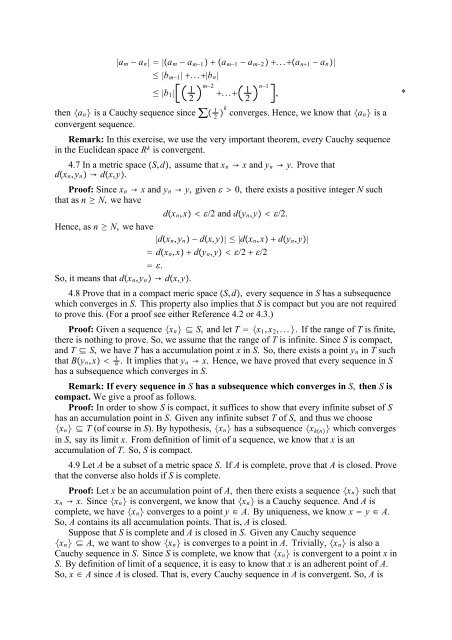The Real And Complex Number Systems
The Real And Complex Number Systems
The Real And Complex Number Systems
Create successful ePaper yourself
Turn your PDF publications into a flip-book with our unique Google optimized e-Paper software.
|a m a n| |a m a m1 a m1 a m2 ...a n1 a n |<br />
|b m1 | ...|b n|<br />
|b 1 | 1<br />
2<br />
m2<br />
... 1<br />
2<br />
n1<br />
, *<br />
then a n is a Cauchy sequence since 1 2 k converges. Hence, we know that a n is a<br />
convergent sequence.<br />
Remark: In this exercise, we use the very important theorem, every Cauchy sequence<br />
in the Euclidean space R k is convergent.<br />
4.7 In a metric space S, d, assume that x n x and y n y. Prove that<br />
dx n , y n dx, y.<br />
Proof: Since x n x and y n y, given 0, there exists a positive integer N such<br />
that as n N, wehave<br />
dx n , x /2 and dy n , y /2.<br />
Hence, as n N, wehave<br />
|dx n , y n dx, y| |dx n , x dy n , y|<br />
dx n , x dy n , y /2 /2<br />
.<br />
So, it means that dx n , y n dx, y.<br />
4.8 Prove that in a compact meric space S, d, every sequence in S has a subsequence<br />
which converges in S. This property also implies that S is compact but you are not required<br />
to prove this. (For a proof see either Reference 4.2 or 4.3.)<br />
Proof: Given a sequence x n S, and let T x 1 , x 2 ,.... If the range of T is finite,<br />
there is nothing to prove. So, we assume that the range of T is infinite. Since S is compact,<br />
and T S, wehaveT has a accumulation point x in S. So, there exists a point y n in T such<br />
that By n , x 1 n . It implies that y n x. Hence, we have proved that every sequence in S<br />
has a subsequence which converges in S.<br />
Remark: If every sequence in S has a subsequence which converges in S, then S is<br />
compact. We give a proof as follows.<br />
Proof: In order to show S is compact, it suffices to show that every infinite subset of S<br />
has an accumulation point in S. Given any infinite subset T of S, and thus we choose<br />
x n T (of course in S). By hypothesis, x n has a subsequence x kn which converges<br />
in S, say its limit x. From definition of limit of a sequence, we know that x is an<br />
accumulation of T. So,S is compact.<br />
4.9 Let A beasubsetofametricspaceS. IfA is complete, prove that A is closed. Prove<br />
that the converse also holds if S is complete.<br />
Proof: Let x be an accumulation point of A, then there exists a sequence x n such that<br />
x n x. Sincex n is convergent, we know that x n is a Cauchy sequence. <strong>And</strong> A is<br />
complete, we have x n converges to a point y A. By uniqueness, we know x y A.<br />
So, A contains its all accumulation points. That is, A is closed.<br />
Suppose that S is complete and A is closed in S. Given any Cauchy sequence<br />
x n A, we want to show x n is converges to a point in A. Trivially, x n is also a<br />
Cauchy sequence in S. SinceS is complete, we know that x n is convergent to a point x in<br />
S. By definition of limit of a sequence, it is easy to know that x is an adherent point of A.<br />
So, x A since A is closed. That is, every Cauchy sequence in A is convergent. So, A is
















